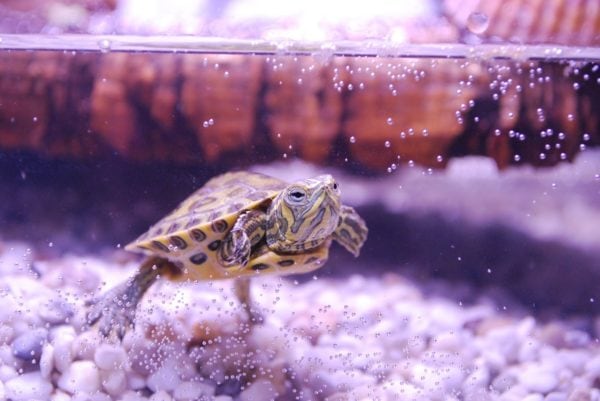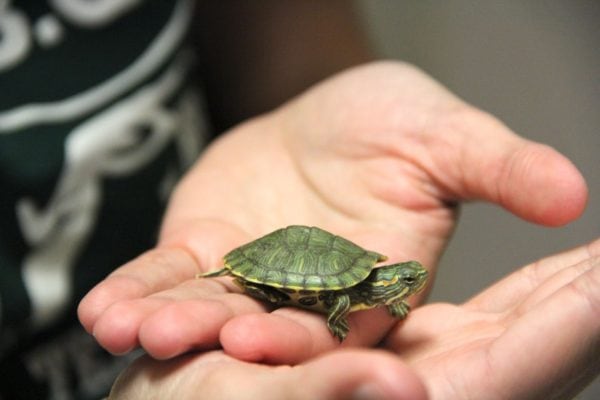Turtles are not what comes to mind when one talks about pets but they make for a great choice for the same. They may not be as communicative and present around as the conventional set of pets like cats and dogs, but they are insanely adorable and make you fall in love with them. They also live for very long when compared to another pet which is an added bonus in case you are looking for a long-standing commitment in the form of a house-pet. With optimum care and proper housing and feeding arrangements, you can have a turtle as a pet for a very long time. If what is getting you wound up is the question as to how to take care of a turtle, fret not, we have got you covered.
Looking for a pet turtle? The African sideneck turtle could be the perfect exotic addition to your home.
Table of Contents
How to Care for a Pet Turtle
Bringing home a pet turtle is not a mighty task but like all other pets, they thrive and live longer in homes where they are looked after well. This applies to your turtle as well. From choosing an appropriate tank to providing the optimal living conditions and feeding them well, right down to making sure they are healthy by carrying periodical check-ups, your pet turtle will thrive if it is all done well. It may sound too huge a task but in practise, the requirements you need to meet to set up a habitat for your turtle are quite simple and straightforward.

Always set up a big tank for your turtle. A general rule is that the tank should be 10 U.S Gallons in capacity per one inch of the turtle’s length. For example, if your pet turtle is 3 inches long, the size of your aquarium should be close to 20 U.S Gallons.
The tank should also be deep enough for the turtles to swim. Although turtles are terrestrial, some species of aquatic turtles like to swim in deep waters, so providing them with a slightly deeper tank would help them thrive.
As far as landscaping of the tank is concerned, it is suggested that the bottom couple of inches of the aquarium be covered in a mixture of peat moss, soil and wood chips. Avoid putting any gravel or decorative rocks on the bed of the tank as the turtles would be likely to munch on them resulting in them choking. While you are at it, you can also raise a small hillock of peat moss on the side of the tank.
Water in the tank should have low chlorine levels. The temperature of the water in the tank needs to be maintained at a balmy level at all times. It is highly suggested that a lamp be lit above the tank. The lamp can be switched off but it needs to be made sure that the temperature of the water does not fall below 18 degree Celsius.
The pH level of the water in the tank should be between 6.0 and 8.0 i.e. pH neutral. Ammonia levels for the water should be zero, the Nitrite levels should be less than 0.4 parts per million and Nitrate levels should be less than 40 parts per million. Periodic testing of water is highly advised to maintain the above levels in the tank.
Feeding Your Turtle: What Do Turtles Eat?
Given that there are various species of turtles that can be adopted and reared as pets, the diet that is administered to them also changes based on this species disparity. The turtle you own may be carnivorous, omnivorous or herbivorous, it’s feeding pattern and food intake will largely be based on that.
Being a carnivore means that the diet of the creature is purely meat based. Whereas being herbivorous means that their diet is completely plant based. Omnivorous is the combination of both traits wherein the creature eats both meat and plant based food.
Turtles seem like a very docile animal and it does not have the agility of a predatory animal, they almost purely have only meat based non vegetarian food while they are young. As they grow, their dependence on plant based food becomes more reinforced. Turtles in the wild depend mostly on insects, worms, snails and small fish. So when you do get a turtle home as a pet, their diet necessities are somewhat similar to their wild counterparts. Domesticated Turtles are mostly aquatic in nature and hence follow an omnivorous diet. There are certain markers to be kept in mind though while feeding your turtle.
Meats and Non-Vegetarian Diet:
Younger turtles have the tendency to feed on meat to fill up on ample proteins as they are growing. Smaller fish like comet goldfish and assorted feeder fish make for great feeding options for turtles. They particularly love to chomp on worms and small insects. Cooked meats and frozen or dried shrimp are also a part of their diet that the turtles particularly enjoy.
However, it needs to be kept in mind that a carnivore diet is to be fed to a turtle sparingly, almost as a treat. It should ideally make up for about 20-25 per cent of the turtle’s diet and be given to them once a week.
Food Pellets
Commercially available food pellets specially made for the turtles are the safest and most comfortable choice made to feed your turtle. These pellets are specifically designed for the turtles and float on the surface of the water tank making it easier for the turtle to feed. The food pellets are also rich in nutrients and vitamins required by the turtle making sure to fill the nutrient gaps in the turtle, if any.
The turtle food pellets should make up for about a quarter of its diet. They can be given to the turtle every day when they are younger and may be decreased to every second or third day when they are older.
Fruits and Vegetables
Most turtles that are terrestrial are purely herbivores. But that is not the case with aquatic turtles and most of the domestic turtle species. That being said, the importance of fruits and vegetables in their diet cannot be short-changed as they become the major source of providing minerals to the turtle. Aquatic turtles love to chomp on water hyacinth. Turtles can be offered diced up fruit like apples, slices of orange, melons and berries. They also eat denser vegetables like zucchini, carrots and squash.
There is no firm rule as to what fruits and vegetables need to be fed to the turtle but they are generally not fed iceberg lettuce and celery based on a simple fact that they are nutritionally not dense. Feeding exotic fishes like the regular Goldfish and Cichlids to a turtle are a strict no-no. They are usually harmful to the turtle as they bear certain infections, are venomous or not nutritionally optimal. Crustaceans like lobster and crab could also cause harm to the turtle.
Tips to keep your turtle healthy

- In terms of feeding, it is a common norm to throw pieces of bread at pets and that is what is followed when it comes to the turtle. It is to be noted that bread is not a great feeding option for a turtle. It does not have the required nutrients that the turtle requires and also has amounts of salt and sugar present in it which should not be fed to a turtle. A perfect snack or a treat for your turtle would be dried shrimp, mealworms or crickets.
- Turtles are known to go months without eating anything for weeks together but that is mostly the case with the turtles living in the wild. Under domestication, turtles flourish best when taken care of consistently and carefully. If the turtle is under one year of age, feeding every day should be the norm. For the older turtles, once in two to three days is acceptable.
- One thing that is very important to keep turtles healthy is keeping their calcium levels steady. It is therefore advised that powdered calcium carbonate powder be added to their feed once every week. This calcium supplementation is required by the turtles to maintain their shells strong.
- It is imperative to give your pet turtles a thorough inspection once a week. A quick inspection once in a day should also be good enough to keep a check if your turtle is in good health. Turtles are prone to infections, malnutrition and problems related to the eye. Looking for symptoms that seem out of the ordinary will let you administer medication or related help to the turtle in time.
- Keeping the tank clean is something that is underrated but is very important for the general health of the turtle. Make sure to use a net to remove the droppings and fallen feed waste from the tent almost every day.
- Attach a water filter to the tank and clean it regularly. Also keep the cover on the tank when unattended so that the turtle does not escape. It is also advised to change 25% of the water from the tank every week to keep it clean. The tank, however, needs a full blown cleaning once every three weeks
One very important thing that needs to be noted while taking care of a turtle is that they are known to be the carriers of salmonella that causes severe infections in humans. So it is imperative that whenever you put your hand in the tank to clean up or pick up debris or to handle your turtle, make sure you wear gloves or clean your hands with competent bleach afterwards. The tank houses the turtle the longest and maintaining basic hygiene while handling the turtle in the tank is very essential.
FAQ’s
Turtles may not be cuddly but they make great pets, bringing home one will surely make you very happy. They thrive when provided with the right housing conditions, healthy balanced diet and hygienic environment. Setting up the ample sized aquarium tank with the right markers and landscaping is the first step. Feeding it nutritious food and consistent health checkups are enough to keep your pet happy and living for long.
Turtles are fairly easier to take care of when compared to certain larger fish that can be bred and housed in an aquarium. Turtles, especially aquatic turtles are more popular pet choices. Given the open space to swim in and clean swimming water will have half your job done.
Like most pets, turtles grow familiar with time. They are known to swim around their owner’s hands when they put it in the tank to show that they trust them. They also start swimming closer and grow less apprehensive. In terms of care, turtles absolutely have to be fed their optimal diet. They also need supplementation for Vitamin A calcium on a regular basis.
Conclusion
Getting a turtle home is not the equivalent of getting a couple of fishes home from the pet store. Turtles require more care and look after than your regular aquarium dwellers. Compared to the conventional pets like the cat or the dog, the turtle does not demand hourly attention, sure. But it still needs to be taken good care of. A turtle has a very long lifespan, so consider that when you are buying a turtle. If you buy a turtle as a pet for your home, it will most likely live in your home through generations and that is something very precious, having a pet carry a legacy for so long. With the right amount of love, care and vigilant nourishment, a turtle could make for a great pet.
If you are convinced about bringing a turtle home, read our various guides on trutle to help you get in the right groove to set things up for your pet turtle.
